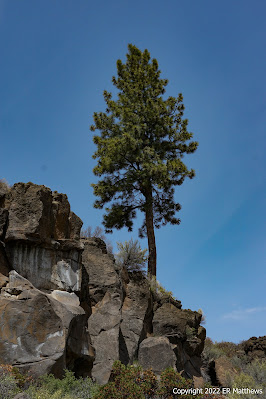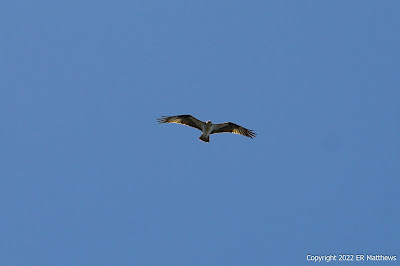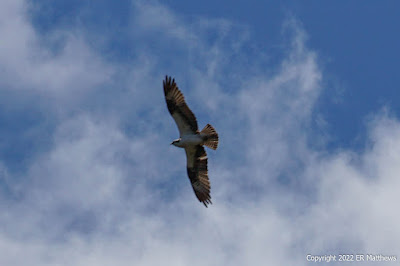We're extremely fortunate to live on a National Wild and Scenic River, the Deschutes, one of the prettiest whitewater rivers that I have ever seen. Here in the south of Bend, Oregon, the river narrows and screams through what is known as the South Canyon, our playground now since February.
Our section of the canyon runs roughly from the irrigation canal inlet on the river to the Deschutes River Trail pedestrian bridge. On the east side of the river runs a gravel road beside the Central Oregon Irrigation District pipeline; this road provides access to the river for our neighborhood, opportunities to get down into the canyon being very limited by the steep cliffs.
We walk the river multiple times a week and I thought that it might be interesting to bring my camera along just to shoot what there is to shoot. If for no other reason, this is a good opportunity to better learn the new Sony camera that I bought in July. The controls are still unnatural to me, having shot Nikon all my life, but I am learning. The following photos were all taken during the third week in May.
Riverscape
 |
| Oregon Grape, Riverside |
Treescape
The general treescape on the eastern Cascade slopes is dominated by majestic Ponderosa Pines soaring well over 100 feet high and the South Canyon is no exception. Further east in the drier desert, the Western Juniper supplants the Ponderosa, but in the Canyon, junipers are scarce. But in a nod to our last home over in the Willamette Valley, where the Douglas Fir reigns supreme, the canyon, unlike most of the terrain around here, has quite a few firs, some quite large and elegant, while the rest of the area does not. The canyon is also home to another pine, the Lodgepole Pine, which contrasts in form, size, needle length, and cones from the ubiquitous Ponderosas.
 |
| Ponderosa Pine, King of the Canyon |
 |
| Ponderosa Needles and Cones |
 |
| Ponderosa Cones |
 |
| Lodgepole Pine Needles and Cones |
 |
| Douglas Fir Needles and Cones |
 |
| Western Junipers are Less Common Here |
Deciduous trees are not very common here, Quaking Aspens being really the only deciduous trees for miles, where the beavers do not mow them down. The remaining so-called trees, I think of as shrubs.
 |
| Uncommon Quaking Aspen |
 |
| Quaking Aspen: Beaver Snacks |
Shrubs
One person's tree is another's shrub and vice versa. I get it. In my book, if the plant in question stays short and compact, especially if it has many trunks rather than a single trunk, it's a shrub. Right on the water, the river banks are lined in all manner of shrubs, most of which have not leafed out at this point: alders, willows, Woods' Rose, and Red-Twigged Dogwood.
 |
| Willow with Catkins, Starting to Leaf Out |
 |
| Oregon Cherry, Prunus emarginata |
 |
| Choke Cherry, Prunus virginiana, Not Yet Blooming |
 |
| Western Serviceberry, Amelanchier alnifolia |
 |
| Riverside Serviceberry |
 |
| An Unknown Mountain Ash, Sorbus sp. |
One of the prettier shrubs earlier in the season is the Oregon state flower, the Oregon Grape. Three types are readily found in the South Canyon: the official state flower, the tall holly-leaved
Mahonia aquifolium; the short and sprawling, dull-leaved
Mahonia repens; and any number of hybrid
M. aquifolium x
repens with intermediate characteristics.
 |
| Tall Oregon Grape |
 |
| Creeping Oregon Grape |
 |
| Natural Hybrid Oregon Grape |
The big six eastside high desert shrubs are well represented in the canyon, with the exception of Big Sagebrush, which I have never found in this area. Snowbrush is scattered throughout the hillsides, but it is relatively uncommon compared to manzanitas and bitterbrush.
 |
| Antelope Bitterbrush, Purshia tridentata |
 |
| Greenleaf Manzanita, Arctostaphylos patula |
 |
| Manzanita, Beautiful Even in Death |
 |
| Gray Rabbitbrush, Ericameria nauseosa |
 |
| Wax Currant, Ribes cereum |
 |
| Snowbrush Budding, Ceanothus velutinus |
Wildflowers
The woods in the canyon are not home to copious wildflowers, especially ones in bloom this early in the year.
 |
| Starry False Solomon's Seal, Maianthemum stellatum |
 |
| Common Dandelion, Taraxacum officinale, is Really Beautiful |
 |
| Some Areas Have a Lot of Lupines |
 |
| Holbøll's Rockcress, Arabis holboellii |
 |
| Escaped Daffodils (Narcissus sp.) Growing Riverside |
 |
| Non-Native Invasive Redstem Storksbill (Erodium cicutarium) |
Ferns and Grasses
The canyon isn't really a haven for either ferns or grasses. There seem to be very few ferns at all while there are pockets of grasses here and there. I'm not terribly interested in grasses, but I find the form of the Bulbous Bluegrass, a non-native invasive, interesting.
I've seen Yellow-pine Chipmunks, Blacktail Deer, beavers, and muskrats, but they're never around when I have the camera in hand. There are cougars (rarely, young males looking for territory), otters, weasels, and skunks, but I've never seen any of these. On the other hand, tree squirrels are out and about when I walk through. The really small Douglas' Squirrels are hard to catch sitting still, but the very large (when compared to the eastern variety) Western Grey Squirrels are much more docile. The grey squirrels, however, are small compared to the California Ground Squirrel that was our local squirrel living on the hazelnut orchard back in McMinnville.
 |
| Wary Douglas's Squirrel |
 |
| Western Grey Squirrel |
Birds
The South Canyon appears to be a haven for birds, not to mention a great migration corridor. I have seen dozens of birds that I have been unable to photograph, mainly small warblers, Pygmy Nuthatches, and Empidonax flycatchers. I've seen a lot of Alder Flycatchers, but getting them in focus hasn't happened so far.
The river through the canyon is whitewater and so most of the dabbling ducks, geese, mergansers, and herons that I have seen do not venture this far south. They start to appear on the flatwater just south of the Reed Market Bridge as do the majority of the blackbirds, especially the Red-Wings, the marsh nesters. We do see Brewer's Blackbirds in the canyon from time to time.
Similarly, I have seen four species of swallows down on the flatwater, but up in the rocky canyon, I only ever see Violet-Green Swallows swooping like miniature fighter jets through the gorge, seldom landing for a photo-op.
And while a trip down the river through the canyon is rarely without a sighting of jays, mainly Steller's and fewer California Scrub Jays, none would pose for me this week. Ditto for woodpeckers, the most common of which is the flicker. We also have both Downy and Hairy Woodpeckers who are more often heard than seen, up in the trees.












































































No comments:
Post a Comment